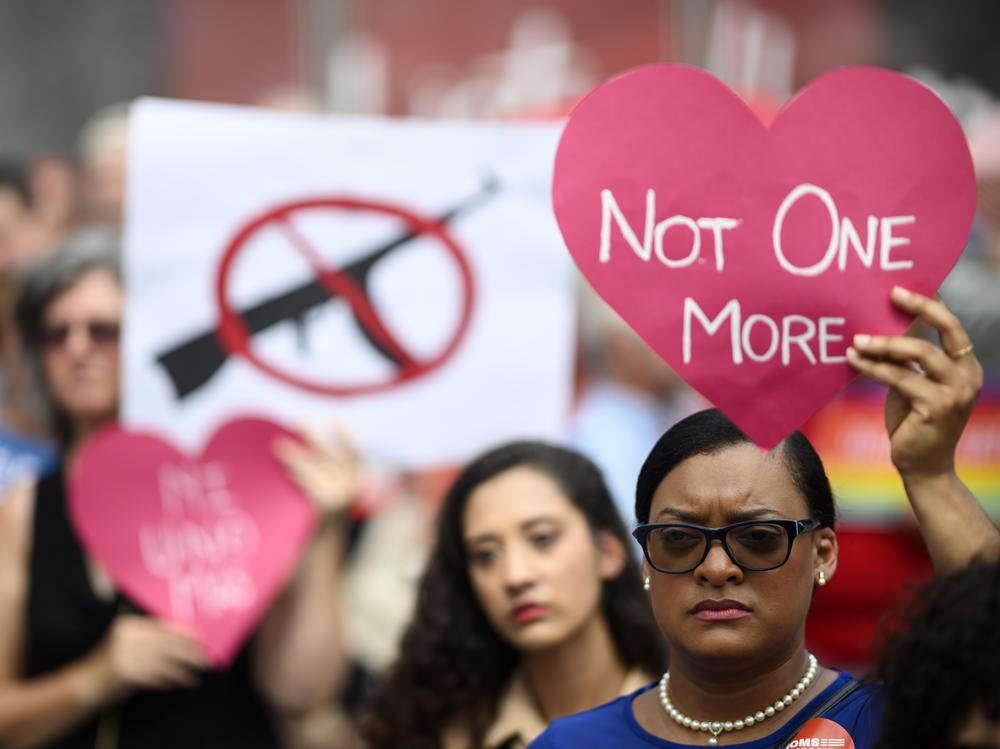Section Branding
Header Content
Premature deaths from guns expose another toll of the firearms crisis
Primary Content
Firearm-related deaths are continuing their rapid rise in the U.S., with a new study finding they have overtaken car crashes as the leading cause of "years of potential life lost" due to trauma.
Using data from the Centers for Disease Control and Prevention, researchers examined the "years of potential life lost" (YPLL) due to firearms within specific populations and geographic regions over the last decade.
In a study published in the journal Trauma Surgery & Acute Care Open on Tuesday, they found that firearms overtook car crashes as the single largest cause of traumatic death in the U.S. in 2017 and 2018, with suicide responsible for the most YPLL from firearms deaths. Older white males were most affected by suicide, and younger Black males were most affected by homicide. Researchers pointed to the policy applications of the study.
"More resources should be redirected and allocated to these at-risk populations to decrease this potentially preventable cause of death and years of life lost," wrote the research team, which was led by Dr. Joshua Klein of the Westchester Medical Center.
Counting an individual's age at death
The team calculated years of potential life lost by using the CDC standard of subtracting the age at death from 80, then adding the individual years of potential life lost across each cause of death. They used data from 2009 to 2018, extracted from two agency sources: the National Vital Statistics Reports and Web-based Injury Statistics Query and Reporting System database.
Klein explained to NPR over email that the leading cause of death only takes into account the total number of individuals who died, while YPLL factors in the individual's age at death. He characterized it as an estimate — based on the average human life span — of the time a person would have lived.
"Years of potential life lost (YPLL), we believe, is a better indicator in revealing the magnitude of the firearm epidemic in the United States," he added. "Calculating YPLL secondary to firearms better quantifies the economic and social losses that occur with these premature deaths."
He traced the motivation for the study back to a discussion about CDC data repeatedly showing an increase in firearm deaths in the U.S., which he said was concerning but "only told one piece of the story."
Researchers set out to examine the evolution of firearm-related deaths on the basis of sex, race and geographical location.
They found that the YPLL for firearms was 1.42 million in 2018, compared with 1.34 million for car accidents. Firearm-related deaths were highest in the South, followed by the West, Midwest and Northeast.
Men made up the vast majority — 85.4% — of the 38,929 firearm deaths reported by the CDC in 2018. That year, firearm suicide was highest among white males, making up 49.3% of total firearm deaths. Firearm homicide was highest in the Black male population, making up 18.3% of the total share.
During that 10-year period, white men had 4.95 million years of potential life lost due to firearm suicide, while Black men had 3.2 million years of potential life lost due to homicide-related firearm deaths.
Klein pointed to these two hard-hit populations as a case study for why YPLL is a "better indicator in discussing the firearm epidemic."
"If one were to just examine the total number of deaths it would be noted that over 170,000 white male suicides occurred and just over 63,000 black male homicides occurred over this 10 year period — both astonishingly high numbers," he said, adding that they don't paint the full picture.
Young Black men lose more years of potential life
He said further calculations show that Black male homicides account for an average 50.5 YPLL per death, while white male suicides account for 29.1 YPLL.
"By including this data, we see that despite the large disparity in total number of deaths between these two populations, due to the younger age of Black male homicide victims, the YPLL are actually closer than would be expected over the study period (4.95 million YPLL vs 3.2 million YPLL)," he explained.
Researchers say that understanding the epidemiology of trauma can aid with better resource allocation, awareness, public information and suicide and injury prevention efforts.
They cited previous studies showing that the U.S. struggles more with firearm ownership, mass shootings, injuries and death when compared with other developed countries.
And while the number of firearms within a state or region cannot fully predict suicide, homicide or violent crime rates, researchers added, the availability of guns should be considered when discussing trauma and injury prevention strategies.
"The demand for total freedom and the second amendment have resulted in high access to firearms in this country and this is undisputable," they wrote. "The main argument is that the right to bear arms to prevent injury or to defend against aggressors may result in a small number of preventable deaths is a plausible theory, however, the data reveal that the resulting access to firearms has equated to magnitudes of death due to firearm suicides in the same individuals demanding access to firearms."
The authors argue that effective suicide prevention efforts should include limiting access to all methods of suicide, firearms included, for at-risk populations.
If you or someone you know may be considering suicide, contact the National Suicide Prevention Lifeline at 1-800-273-8255 (En Español: 1-888-628-9454; Deaf and Hard of Hearing: 1-800-799-4889) or the Crisis Text Line by texting HOME to 741741.
This story originally appeared in the Morning Edition live blog.
Copyright 2022 NPR. To see more, visit https://www.npr.org.

